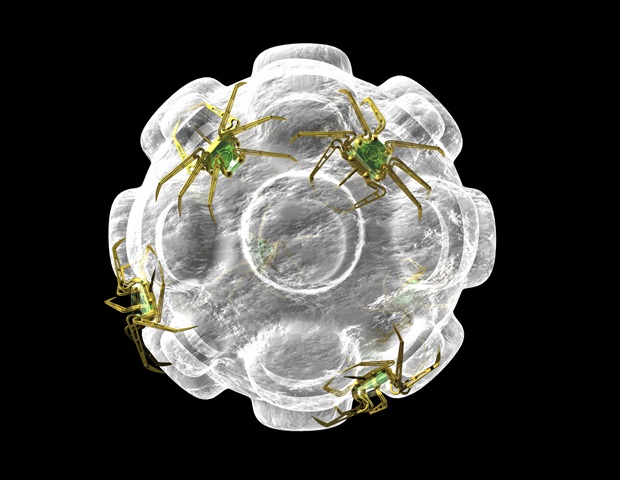
We’ve all heard of antibodies – proteins produced by our our bodies to bind to viruses or micro organism, marking them for elimination by the immune system. However not all of us are aware of aptamers: brief segments of DNA or RNA which are designed to bind, like antibodies, to particular targets. Artificial and cheap to provide, aptamers are engaging alternate options to antibodies for biomedical diagnostics and therapeutics.
When new aptamer binders are wanted, for instance to detect a brand new virus, they’re developed from libraries of thousands and thousands of nucleic acid sequences from which the very best matches for a given goal are chosen and amplified. Till now, such libraries contained solely monovalent binders: sequences that bind to at least one website on a goal molecule. However this contrasts with the construction of many real-world proteins, together with the SARS-CoV-2, influenza, and HIV spike proteins. These constructions, which viruses use to contaminate cells, are comprised of three similar subunits presenting three potential binding websites.
Sadly, utilizing monovalent binders for these three-unit (trimeric) complexes is hit-or-miss. In truth, Maartje Bastings, head of the Programmable Biomaterials Lab in EPFL’s College of Engineering, compares it to “throwing a bowl of spaghetti on the wall, as one thing will definitely stick someplace.”
You possibly can’t management the place a monovalent binder interacts with its goal: for instance, it might bind to the aspect of a protein, slightly than the binding interface, decreasing its performance. In different phrases, you’ll be able to’t select the spot on the wall the place a sure spaghetti noodle will stick. So, we thought: would not or not it’s higher or pre-organize our library for binders that match a goal’s precise geometry? And this strategy seems to be magically efficient.”
Maartje Bastings, Head of the Programmable Biomaterials Lab in EPFL’s College of Engineering
Bastings and her staff have just lately reported the primary method for producing multimeric aptamers, which goal protein complexes with unprecedented precision and performance. Certainly, the binders developed with the lab’s strategy, dubbed MEDUSA (Multivalent Advanced DNA-based SUpramolecular Assemblies), yields binding affinities which are between 10 and 1,000 occasions stronger than these achieved with monovalent binders. Along with being stronger, additionally they turned out to be way more selective, which is important for diagnostics. The analysis has been printed in Nature Nanotechnology.
A bioinspired strategy
The important thing to creating trimeric binders is the scaffold: a molecular construction round which three binding models naturally assemble. Of their experiments, the researchers developed their scaffold primarily based on the geometry of the SARS-CoV-2 spike protein. By including these tailor-made scaffolds to their aptamer library, the staff was capable of bias the sequence area towards trimeric candidates that may bind functionally to the goal interface proper from the beginning.
“We’ve retro-engineered the pure paradigm seen in viruses, wherein multivalent molecular complexes co-evolve, and translated it into a brand new binder discovery methodology that enables us to pick out multivalent binders that may block such viruses,” summarizes PhD pupil and first writer Artem Kononenko.
As soon as a primary batch of binders is recognized, candidates with growing affinity for his or her goal are developed via an iterative means of choice and amplification known as ‘evolution’.
Though designing new scaffolds can take a matter of hours, the evolution course of can take weeks. Wanting forward, the analysis staff goals to shorten this timeframe to higher go well with the wants of biomedical diagnostics and therapeutics.
One other aim is to develop multimeric binders focusing on pathogens with much more complicated configurations, like Dengue fever (six binding subunits) or anthrax (seven). “In the end, we need to use this new multivalent sequence area to coach generative synthetic intelligence fashions to do that for us,” Bastings says.
Supply:
Journal reference:
Kononenko, A., et al. (2025). Evolution of multivalent supramolecular assemblies of aptamers with target-defined spatial group. Nature Nanotechnology. doi.org/10.1038/s41565-025-01939-8.